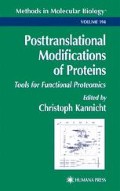Abstract
Among the twenty amino acids that comprise proteins, cysteine has unique properties. It may contribute to protein biological functions by using its sulfhydryl (-SH) group in the active site for enzyme catalysis such as in cysteine proteases, as the chelating site for metal ions, or as the active site of disulfide-reshuffling enzymes (1). The oxidation of sulfhydryl groups to form a disulfide bond is one of the most common posttranslational modifications in proteins. Disulfide bonds play an important role in folding/refolding processes and in maintaining the three-dimensional structure of proteins. The determination of disulfide-bond linkage is therefore an integral part of structural characterization of proteins (2).
Access this chapter
Tax calculation will be finalised at checkout
Purchases are for personal use only
References
Freedman R. B., Hirst T. R., and Tuite M. F. (1994) Protein disulfide isomerase: building bridges in protein folding. Trends Biochem. Sci. 19, 331–336.
Creighton T. E. (1984) Disulfide bond formation in proteins, in Methods in Enzymology, vol. 107 (Wold F. and Moldave K., eds.), Academic, San Diego, CA, pp. 305–329.
Smith D. L. and Zhou Z. (1990) Strategies for locating disulfide bonds in proteins, in Methods in Enzymology, vol. 193 (McCloskey J. A., ed.), Academic, New York, pp. 374–389.
Hirayama K. and Akashi S. (1994) Assignment of disulfide bonds in proteins, in Biological Mass Spectrometry: Present and Future (Matsuo T., Caprioli R. M., Gross M. L., and Seyama Y., eds.), Wiley, New York, pp. 299–312.
Jacobson G. R., Schaffer M. H., Stark G. R., and Vanaman T. C. (1973) Specific chemical cleavage in high yield at the amino peptide bonds of cysteine and cystine residues. J. Biol. Chem. 248, 6583–6591.
Wakselman M. and Guibe-Jampel E. (1976) 1-Cyano-4-dimethylamino-pyridinium salts: new water-soluble reagents for the cyanylation of protein sulphydryl groups. JCS Chem. Comm. 21–22.
Nakagawa S., Tamakashi Y., Hamana T., Kawase M., Taketomi S., Ishibashi Y., et al. (1994) Chemical cleavage of recombinant fusion proteins to yield peptide amides. J. Am. Chem. Soc. 116, 5513–5514.
Nakagawa S., Tamakashi Y., Ishibashi Y., Kawase M., Taketomi S., Nishimura O., and Fukuda T. (1994) Production of human PTH (1–34) via a recombinant DNA technique. Biochem. Biophys. Res. Commun. 200, 1735–1741.
Wu J. and Watson J. T. (1998) Optimization of the cleavage reaction for cyanyl-ated cysteinyl proteins for efficient and simplified mass mapping. Anal. Biochem. 258, 268–276.
Wu J., Gage D. A., and Watson J. T. (1996). A strategy to locate cysteine residues in proteins by specific chemical cleavage followed by matrix-assisted laser desorption/ionization time-of-flight mass spectrometry. Anal. Biochem. 235, 161–174.
Wu J. and Watson J. T. (1997) A novel methodology for assignment of disulfide bond pairings in proteins. Protein Sci. 6, 391–398.
Yang Y., Wu J., and Watson J. T. (1998) Disulfide mass mapping in proteins containing adjacent cysteines is possible with cyanylation/cleavage methodology. J. Am. Chem. Soc. 120, 5834–5835.
Putney S., Herlihy W., Royal N., Pang H., Aposhian H. V., Pickering L., et al. (1984) Rabbit muscle creatine phosphokinase cDNA clone, primary structure and detection of human homologues. J. Biol. Chem. 259, 14,317–14,320.
Gray W. R. (1993). Disulfide structures of highly bridged peptides: a new strategy for analysis. Protein Sci. 2, 1732–1748.
Gray W. R. (1993) Echistatin disulfide bridges: selective reduction and linkage assignment. Protein Sci. 2, 1749–1755.
Schutte C. G., Lemm T., Glombitza G. J., and Sandhoff K. (1998) Complete localization of disulfide bonds in GM2 activator protein. Protein Sci. 7, 1039–1045.
Wu J., Yang Y., and Watson J. T. (1998) Trapping of intermediates during the refolding of recombinant human epidermal growth factor (hEGF) by cyanylation, and subsequent structural elucidation by mass spectrometry. Protein Sci. 7, 1017–1028.
Hober S., Forsberg G., Palm G., Hartmanis M., and Nilsson B. (1992) Disulfide exchange folding of insulin-like growth factor-I. Biochemistry 31, 1749–1756.
Regnier F. E. and Gooding K. M. (1980) High-performance liquid chromatogra-phy of proteins. Anal. Biochem. 103, 1–25.
Rubinstein M. (1979) Preparative high-performance liquid partition chromatog-raphy of proteins. Anal. Biochem. 98, 1–7.
Author information
Authors and Affiliations
Editor information
Editors and Affiliations
Rights and permissions
Copyright information
© 2002 Humana Press Inc.
About this protocol
Cite this protocol
Wu, J., Watson, J.T. (2002). Assignment of Disulfide Bonds in Proteins by Chemical Cleavage and Peptide Mapping by Mass Spectrometry. In: Kannicht, C. (eds) Posttranslational Modifications of Proteins. Methods in Molecular Biology™, vol 194. Humana Press. https://doi.org/10.1385/1-59259-181-7:001
Download citation
DOI: https://doi.org/10.1385/1-59259-181-7:001
Publisher Name: Humana Press
Print ISBN: 978-0-89603-678-9
Online ISBN: 978-1-59259-181-7
eBook Packages: Springer Protocols

